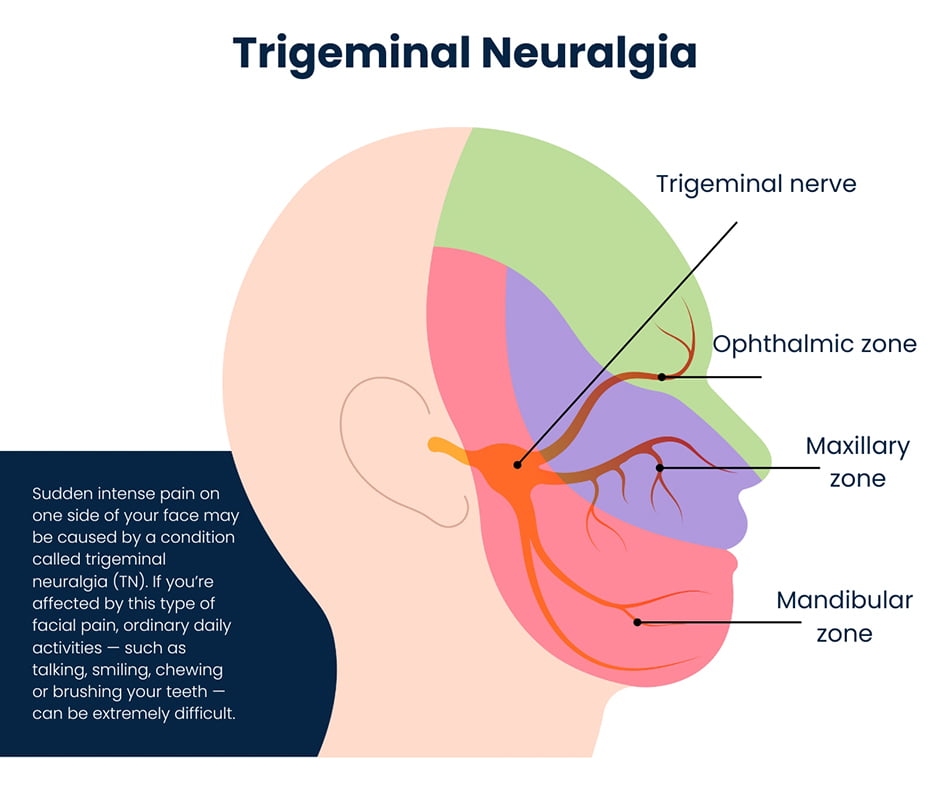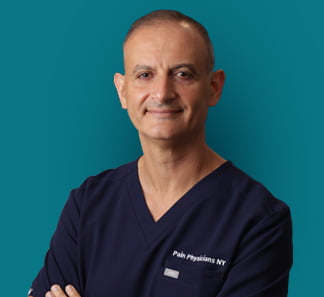When you have pain anywhere in your face, you probably don’t think of trigeminal neuralgia right away. Many general practitioners wouldn’t either. But when you see a specially trained facial pain doctor, like those at Pain Management NYC, that’s one of the conditions you’ll be checked for. With the right diagnosis and trigeminal neuralgia treatment, such as a nerve block injection, you can get through the unexplained facial pain with effective solutions.
What Is Trigeminal Neuralgia?
Sudden intense pain on one side of your face may be caused by a condition called trigeminal neuralgia (TN). If you’re affected by this type of facial pain, ordinary daily activities — such as talking, smiling, chewing or brushing your teeth — can be extremely difficult. Bouts of pain may be short-lived, but return sporadically, or you may have facial pain that’s constant but less intense. Another name for trigeminal neuralgia is tic douloureaux, which means “painful tic.”
If you have unexplained facial pain, or if you have previously been diagnosed with trigeminal neuralgia, you need an expert facial pain specialist who’s committed to staying up to date on the latest options in trigeminal neuralgia treatments. That’s exactly what you’ll find at Pain Management NYC. They provide a standard of pain management care that’s recognized to be among the best in the country.

What Causes Trigeminal Neuralgia?
Pressure on the trigeminal nerve causes TN. The trigeminal nerve is a three-part cranial nerve that provides nerve signaling and feeling to parts of the face and head. There are two of these nerves, one for each side of the face.
Some of the causes of TN include:
- Oral surgery, sinus surgery or general dental work
- Any type of facial trauma
- Stroke
- Conditions such as multiple sclerosis in which the myelin sheath protecting nerves is damaged
- Arteriovenous malformation, which is a tangle of blood vessels that disrupt blood flow
TN can occur at any age, but it most often affects people over the age of 50. For unknown reasons, TN affects women more often than men. When there’s damage to the trigeminal nerve from any cause, pain may be triggered by touching your face for any reason or by eating, drinking, smiling, brushing your teeth, shaving or talking. Sometimes there’s no identifiable cause for having this condition.
What Are the Symptoms of Trigeminal Neuralgia?
An injury to the trigeminal nerve may affect a small area or one whole side of your face. It’s not unusual for patients to mistake this type of one-sided pain for dental problems.
Symptoms you may experience include:
- Sudden jolts of facial pain that resembles an electric shock
- Pain that lasts from a few seconds to a few minutes
- Facial tingling or numbness
- Burning sensation
- Facial spasms
There may be periods of relief between episodes, but episodes may become more frequent and intense as time passes. TN is the most common cause of facial pain, and the pain of this condition can be debilitating. It usually affects only one side of the face. If both sides are affected, it’s called bilateral trigeminal neuralgia, but this is very rare.
Your NYC facial pain doctor diagnoses TN by examining your head and neck, including your jaw, ears, teeth and mouth. A diagnosis of this condition depends on the specific type of pain you’re experiencing, where on your face it’s located and what triggers the painful episodes.
Related conditions that can cause facial pain need to be ruled out and may include:
- Migraines, brought on by specific triggers
- Cluster headaches
- Temporomandibular joint (TMJ) disorder
- Postherpetic neuralgia, which can occur after an outbreak of shingles
What Are Some Options for Trigeminal Neuralgia Treatment?
Facial pain treatment usually starts with medication and may eventually include surgery if medication is ineffective, side effects are intolerable, or it stops working as time passes.
Trigeminal neuralgia treatment may include:
- Anticonvulsants. Medications used to treat seizures block nerve firing and are more effective for treating Type 1 TN than Type 2.
- Tricyclic antidepressants. Some antidepressants reduce pain in Type 2 TN.
- Muscle relaxants. These may be prescribed alone or in combination with other medications.
- Nerve block injection. A nerve block injected near an inflamed nerve blocks pain on a temporary basis.
- Surgery. There are several surgical options that are used to treat TN when other approaches are unsuccessful. These include rhizotomy, radiofrequency ablation, balloon compression and microvascular decompression.
Medication and surgery combined with complementary approaches to treatment trigeminal neuralgia option may include:
- Meditation
- Acupuncture
- Yoga
- Creative visualization
- Aromatherapy
- Biofeedback
- Supportive counseling
Your facial pain doctor determines the treatment approach likely to be most effective for you. Once you start treatment, trigeminal neuralgia symptoms should improve. TN can be a progressive disorder and symptoms can continue to worsen over time. Let your doctor know whether current trigeminal neuralgia treatments are no longer effective.
Are There Different Types of Trigeminal Neuralgia?
On each side of your face, the trigeminal nerves split into three branches. The upper branch provides sensation to the forehead and scalp. The middle branch provides sensation to the teeth and cheeks while the lower branch provides sensation to the lower lip and lower jaw.
TN is divided into two main types:
- Type 1. This form of TN is also known as classic TN and is characterized by intermittent episodes of extreme pain often triggered by contact with the cheek.
- Type 2. This is known as atypical TN. People with this type of TN have constant stabbing or burning pain, but it’s less intense than the intermittent attacks seen in type 1.
It’s possible to have both types of TN. The intensity of the pain of TN can seriously affect your quality of life. You may avoid socializing with other people or participating in your normal activities because you’re fearful of having an attack of pain.
When Should I See a Facial Pain Doctor?
The pain of trigeminal neuralgia can be brought under control when managed by an expert facial pain doctor. If you’re experiencing recurring or ongoing facial pain that’s not relieved with over-the-counter pain medication, you should be evaluated by a knowledgeable and experienced facial pain specialist. Your symptoms should also be evaluated if you have facial twitches or loss of sensation in the scalp or face.
The intensity of the pain of trigeminal neuralgia or other conditions that cause chronic pain such as neuropathy and back paincan make it difficult to do ordinary daily activities. Contact the expert pain management specialists at Pain Management NYC, where you’ll receive the best possible care from award-winning, board-certified doctors.

Boleslav Kosharskyy, MD, is a top-rated, best-in-class interventional pain management doctor. He is board-certified in Anesthesiology, Interventional Pain Medicine, and Palliative Care.
Dr. Kosharskyy is an Associate Professor of Anesthesiology and Rehabilitation Medicine at Albert Einstein Medical College. He’s also the Associate Medical Director of Pain Medicine and Director of Anesthesia for the Joint Replacement Center at Montefiore Medical Center and Albert Einstein Medical College.
He is an active member of the American Society of Anesthesiology (ASA), the American Society of Regional Anesthesia and Pain Medicine (ASRA), and the New York State Society of Anesthesiologists (NYSSA)
